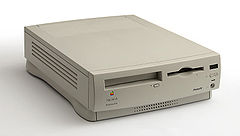
Power Macintosh 6200
Encyclopedia

Personal computer
A personal computer is any general-purpose computer whose size, capabilities, and original sales price make it useful for individuals, and which is intended to be operated directly by an end-user with no intervening computer operator...
s that are a part of Apple Computer
Apple Computer
Apple Inc. is an American multinational corporation that designs and markets consumer electronics, computer software, and personal computers. The company's best-known hardware products include the Macintosh line of computers, the iPod, the iPhone and the iPad...
's Power Macintosh
Power Macintosh
Power Macintosh, later Power Mac, was a line of Apple Macintosh workstation-class personal computers based on various models of PowerPC microprocessors that were developed, marketed, and supported by Apple Inc. from March 1994 until August 2006. The first models were the Power Macintosh 6100,...
and Macintosh Performa
Macintosh Performa
The Macintosh Performa series was Apple Computer's consumer product family of Apple Macintosh personal computers sold through department stores and mass-market retailers from 1992 until 1997, when it was superseded by the Power Macintosh 5x00 series...
series of Macintosh computers. It was introduced in May 1995 with a PowerPC 603 CPU at 75 MHz as a PowerPC
PowerPC
PowerPC is a RISC architecture created by the 1991 Apple–IBM–Motorola alliance, known as AIM...
-based replacement of the Quadra 630, and continued using the 630's case. In June 1996 new models using a PowerPC 603e CPU at 100 MHz followed, and in April 1996 the series culminated in models using a 603e at 120 MHz. In early 1997, the rather different Power Macintosh 6300/160 / Performa 6360 based on the Power Macintosh 6400 were introduced. In July 1997 the whole 6x00 line was discontinued in favor of the desktop model of the Power Macintosh G3
Power Macintosh G3
The Power Macintosh G3, commonly called "beige G3s" or "platinum G3s" for the color of their cases, was a series of personal computers designed, manufactured, and sold by Apple Computer, Inc. from November 1997 to January 1999...
.
The 6200's naming conventions confused many; in addition to the many Performa variants, it also includes model numbers above 6300 (which would normally indicate a different model). The model numbers above 6260 use a PowerPC 603e processor, but are otherwise virtually identical. Finally, some computers with model numbers that indicate they belong to the 6200/6300 family (the above-mentioned Power Macintosh 6300/160 and its Performa version 6360) are rather different on the inside.
Generally, the 6200 series is closely related to the 5200 series. For nearly every 6xxx (desktop) model, there is a 5xxx (all-in-one) model with an integrated CRT screen.
Power Macintosh 6200
The 6200 shares the logic boardLogic board
A logic board is the Apple equivalent of a motherboard. The term logic board was coined back in the 1980s, when the compact Macs at the time had two separate circuit components. The term "logic board" stuck over the years of Macintosh manufacturing, even in the non-all-in-one Macs...
with the Power Macintosh 5200. Because they use a logic board design directly adapted from the 32-bit Quadra with a 64-bit data path CPU, these models are sometimes described as being among the worst Macintoshes ever produced. Other hardware issues include problems with the IDE controller, the SCSI controller and the serial ports.
Models
- Power Macintosh 6200: The 6200 was only sold in Asia under this name. Uses a 500 MB hard drive.
- Performa 6200CD: Basically identical to the Power Macintosh 6200, but comes with a 1 GB hard drive, a 14.4k modem, a bundled monitor and software.
- Performa 6205CD: The 6200CD with an 28.8k modem instead of a 14.4k one.
- Performa 6210CD: The 6205CD with a different software bundle.
- Performa 6214CD: The 6200CD with a different software bundle.
- Performa 6216CD: The 6200CD without the monitor.
- Performa 6218CD: The 6200CD with 16 MB of RAM instead of 8 MB.
- Performa 6220CD: The 6218CD without the monitor, but with a TV / video in/out card.
- Performa 6230CD: The 6220CD with a hardware MPEG decoder card.
Power Macintosh 6300
In May 1996, the 6200 series was upgraded to use the new PowerPC 603e CPU. The rest of the logic board remained unchanged, retaining the same problems and inconsistencies as the earlier models. Two 120 MHz models were introduced in April 1996, again without any change to the underlying architecture.Models
- Performa 6260CD: The Power Macintosh 6200 with a 100 MHz 603e processor and 800MB hard drive. Only sold in Europe and Asia.
- Performa 6290CD: The 6260CD with 1 1.2 GB hard drive. Only sold in North America.
- Power Macintosh 6300/120: The 6290CD with a 120 MHz 603e processor and 16 MB of RAM. Sold only in Asia.
- Performa 6300CD: The 6290CD with 16 MB of RAM and a bundled monitor. Sold only in North America.
- Performa 6310CD: Identical to the 6300CD, but only sold in Asia and Europe.
- Performa 6320CD: The Power Macintosh 6300/120, but with a bundled monitor and a TV/video card.
Power Macintosh 6300/160 / Performa 6360
The Power Macintosh 6300/160 (sold in North America as the Performa 6360) was introduced in October 1996. It still used the same case as the 6200, but featured a new motherboard with a full 64-bit data path and 64-bit DIMM RAM, PCI slot, and Comm Slot II (non compatible upgrade to earlier Comm Slot). The board design was first used in the Power Macintosh 5400/120, and would continue to be used until the Power Macintosh 5400 and 6400 series.Models
- Power Macintosh 6300/160: 160 MHz PowerPC 603e-based desktop computer. Sold only in Europe and Asia.
- Performa 6360: Identical to the Power Macintosh 6300/160. Sold only in North and South America.
External links
- Power Macintosh 6200, 6300/120, 6300/160 and Macintosh Performas at AppleSpec
- Performa 6200 and Performa 6360 at apple-history.com
- Performa 6200, Performa 6300 and Performa 6360 at Low End Mac
- Power Macintosh 6200, 6300/120 and Macintosh Performas at EveryMac.com

